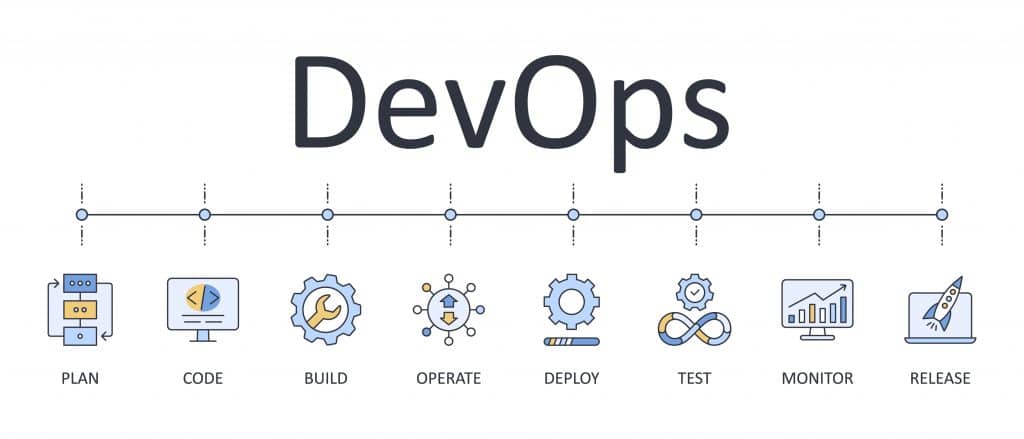Understanding DevOps and how to Automate It
Published on: September 19th, 2022

Today’s rapid technology sector growth puts development and IT operation teams under constant pressure to meet increased customer expectations for different applications. Some of the expectations include extended functionality, improved performance, increased uptime, and guaranteed availability. In addition, with the advent of cloud-based systems, organizations can now develop software as an ongoing service rather than creating them as monolithic structures. As a result, developers can consistently improve products in this new paradigm to meet evolving end-user requirements.
Companies are responding to this new approach by embracing DevOps and automation to streamline development and deployment processes. So, what is the DevOps concept, and how can you automate the practice?
DevOps, as the name suggests, is a combination of two terms – development and operations, representing a collaborative approach to the roles of an organization’s software development and IT operations teams.
In a broader perspective, DevOps is like a recipe combining different ingredients – philosophies, practices, and tools to increase the speed at which an organization delivers applications and services. This desirable DevOps outcome requires companies to evolve and improve products faster than firms using traditional product development and management approaches.
DevOps promotes better collaboration and communication between different teams in an organization, starting with IT operations and software development. Gartner states that DevOps emphasizes people and culture, seeking to improve inter-department collaboration.

Back to our recipe analogy, the secret behind DevOps is how ingredients blend in the right proportions, resulting in an increased value to customers. In this process, an organization adopts various well-known practices and concepts, such as iterative software development, automation, leadership, and programmable infrastructure deployment.
Reasons Organizations Should Care about the DevOps Hype
DevOps offers numerous capabilities to an entire business. Essentially, DevOps is a cultural movement where IT operations and application developers agree that a product does not add value unless the intended clients or employees use it. It is a “framework that aims to build a bridge between IT development and operation to shorten the development cycle at low cost,” writes Arif Ali Khan and Dac-Nhuong Le.
Deploying DevOps practices enables organizations to shorten the time to market and enhance reliability by improving collaboration, trust, and understanding and reducing barriers between development and operation teams. What’s more, this collaboration builds cohesion between different stakeholders, which practically aligns business requirements with technological projects. Ultimately, both application development and IT operation teams can deliver new features, updates, and fixes more frequently to end users.
Additionally, DevOps empowers developers to own, run, and manage end-to-end delivery of software products. With industries and consumers using technology and software daily for different tasks, DevOps allows vendors to develop applications in a unified, automated, and responsive way that offers maximum efficiency.
Teams have a better understanding of the software product since they have access to product functionality and performance data from the end users. As a result, they can develop a strategy to solve pain points and bugs on time.
See how it works:
Ready to streamline your requirements management today?
Why and How to Apply Automation in DevOps Practice
Gartner’s DevOps definition also states that the concept’s implementation utilizes technology, especially automation tools, that “can leverage an increasingly programmable and dynamic infrastructure from a lifecycle perspective.”
Without a doubt, automation allows DevOps stakeholders to accomplish work efficiently. Organizations require in-house or outsourced tools to automate large parts of development and deployment processes. As an ultimate need and key principle of DevOps, automation starts from code generation on a developer’s device until the software is pushed to production. The process continues after that to monitor product performance while in use.
From a practical point of view, DevOps automation can take place in infrastructure setup and configurations, server provisioning, network configurations, firewall setup, and software development, deployment, and monitoring. In addition, the process entails automatic code compilation, verification tests, unit tests, acceptance test cases, and version control.
How to Achieve DevOps Automation
So, how can you achieve automation in DevOps? First, as might be expected, organizations must select the right frameworks and automation tools, both open source and licensed, to ensure end-to-end automation of the product delivery pipeline.
Jarred Murrell writes that it is vital to choose open standards when selecting automation tools. “By maintaining tooling that follows common, open standards, you can simplify onboarding and save time on specialized training.”
Other than that, organizations should use flexible tooling that allows them to change technologies. Simply put, solutions with wide integration ecosystems that work with different cloud services allow teams to define a unique set of best practices and reach defined goals without being restricted by the toolchain.
Importance of Automation in the DevOps Practice
Consider a situation where an organization is deploying applications on a huge cluster involving several servers. If the process is manual, it would involve long online and offline discussions and extensive code freeze periods. The situation gets at its worst, with most developers working overtime to meet deadlines. The sleep-deprived employees lack consistency, making it easy for them to forget something on the way, and if the task is vital, they risk downtimes. These complexities clearly have seen software releases take years to get into the market, highlighting the need for automation in DevOps activities.
Simply put, automation eliminates manual tasks, allowing organizations to achieve DevOps goals efficiently. In essence, it provides consistency across repetitive tasks by configuring tools that eliminate human errors. For that reason, companies can reduce routine tasks and utilize their resources and intelligence to innovate products.

Additionally, automation increases the speed of product stakeholders, from code integration to software deployment. Apart from the swift delivery, automation in DevOps allows companies to produce stable and reliable products due to improved collaboration and reduced miscommunication errors. Consequently, companies can now bring release timelines down to a few weeks or days.
But you know what’s even better than consistency and speed? Automation processes in the DevOps practice are scalable, which is absolutely essential when managing multiple applications, platforms, or environments. So it’s quite obvious that DevOps automation is a must if you want to offer high quality and value to customers via scalable and frequent deliveries.
Besides, introducing automation in DevOps for tasks like application installation and version controlling allows any average person to handle this, thereby reducing dependency on pricey skilled workers. Also, DevOps teams can create automated monitoring rules and generate alerts to track infrastructure availability, performance, and security.
Importance of Automation in the DevOps Practice
Many organizations have adopted DevOps practices to manage code development, testing and releases, but they still have requirements capture ‘siloed’ and disconnected to initiate the process.
Modern Requirements4DevOps is used to help in breaking down the silos by facilitating the capture and management of requirements in the same place as is used in the remaining DevOps process. This allows organizations to create a ‘single source of truth’ in Azure DevOps, providing real time information to all team members. The importance of this single repository is clearly magnified in companies that must submit compliance reporting to industry regulators.
Modern Requirements enables you to automate requirements, enable repeatable processes, increase collaboration, and accelerate project velocity in DevOps. Modern Requirements is the only requirements management solution built directly in Azure DevOps and is a gold partner of Microsoft.
Are you ready to see Modern Requirements4DevOps in practice? Contact us for a Quote ; get a Free Trial or ask us for more information.

